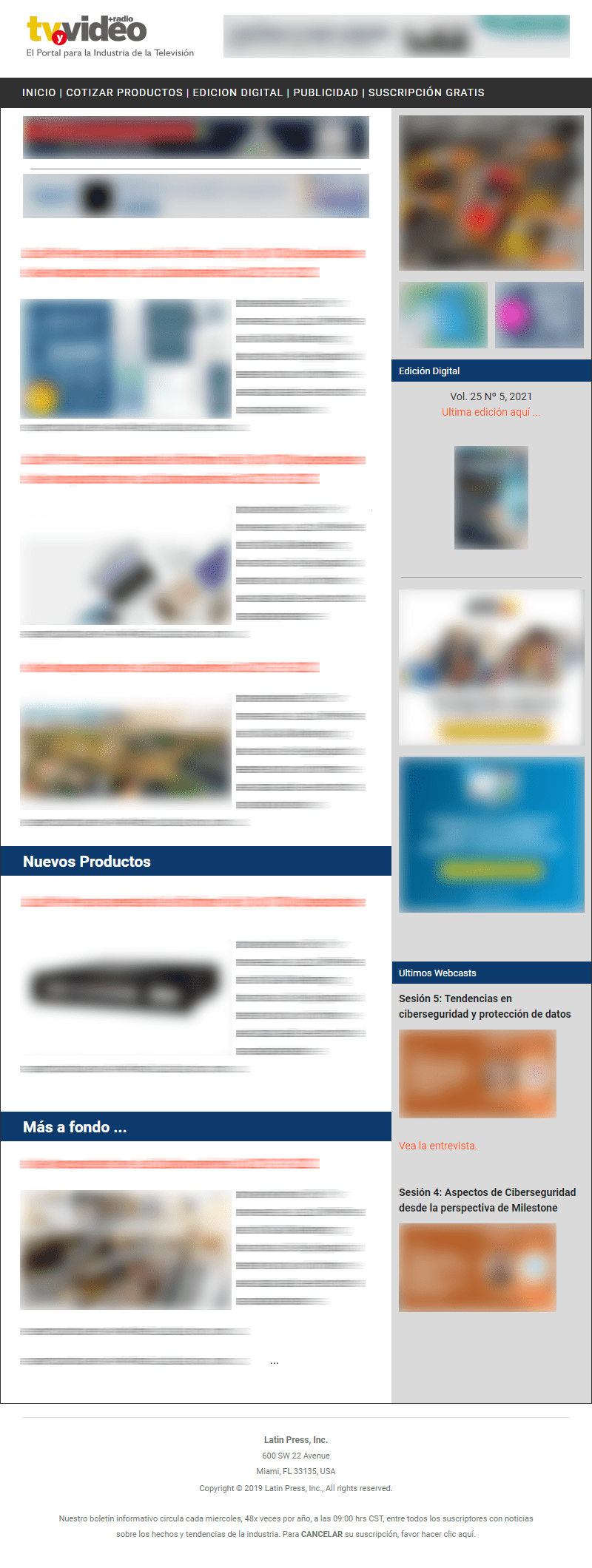Twenty-eight years after the invention was announced in London, television arrived in Colombia becoming a true milestone for the country's communications.
That June 13, 1954, the government of General Gustavo Rojas Pinilla celebrated its first anniversary with the inauguration of television. It was a special moment for Colombia. At the economic level, the bonanza was experienced, the result of good international coffee prices, a fact that allowed the import of expensive equipment by the government. At the political level, the crisis generated by the attrition of the military government against the political and economic groups began. Perhaps television was an important factor that intervened changing the hectic social climate of the time.
Some history
When the transmissions began, there were only 400 television sets in Bogotá, but only 6 months later a ship of the Grancolombiana Merchant Fleet arrived in Cartagena with 5,000 televisions. There were 10,000 more left to complete the total request offered by the government to Colombians. The signal would eventually be extended to Manizales, Alto Magdalena and then to the rest of the country.
Colombian television was born completely in the hands of the State and it was this establishment that was responsible for importing and administering it because it depended directly on the Presidency of the Republic. The technical management, meanwhile, was carried out by a group of Cubans whose mission was to train and train Colombian personnel.
These qualified technicians, who were substantially improving the quality of the programs, and the increase in the number of receivers, together with the decrease in coffee prices, would give rise in 1955, to the emergence of commercial television. The company TVC, short for Commercial Television, of which RCN Radio and Caracol Radio were part, was in charge of exploiting some spaces of the national channel. The nascent commercialization changed the circumstances radically. A growing audience, expanding programming, and a underfunded government that was forced to withdraw its support created the right time for advertisers to enter a medium that previously attracted little attention. In 1957 the government handed over television to private enterprise. At that time began the great audiovisual career in Colombia. By 1960 the transmitting network covered 80 percent of the national territory and every night, two million viewers sat judiciously to follow the incidents of the magic box.
Two years later and despite the academic and intellectual sectors of the time, it gave way to educational education. This medium, which was almost complete a decade, then became a vehicle of mass instruction.
The advance of television and its consolidation in Colombia led to the creation, in December 1963, of the National Institute of Radio and Television -Inravisión. The new institution would be in charge of controlling the chaos that both at the state and private level reigned in the growing environment.
In 1965 the government decided to put out to public tender a second channel, whose lease would allow a more autonomous administration. Then appears the Teletigre, which was born with the support of the American network ABC and that meant a serious competition for channel 1 because its programming, based on ABC series, captivated a considerable part of the audience. On the other hand, the recently awarded channel assumed in its information and opinion spaces a critical position vis-à-vis the government, making the counterweight that the population needed. In 1970 the contract expired without renewal. The famous "pool" of programmers – RTI, PUNCH and CARACOL – divided the programming of channel 2 and ended up making a presence in the two channels.
At the level of content, the sixties were the reign of telenovelas. The decrease in budget for live programs, the founding of RTI, which led to the transition of radio soap operas to this genre in audiovisual, and the extension of transmission networks allowed producers to offer greater audience and national coverage through mass products, that is, telenovelas.
The Satellite Age
The new decade would be of great importance for Colombian television. In February 1970, channel 11 of popular educational television for adults was inaugurated and that same year, on March 25, the Chocontá tracking station came into operation. Thus began the "satellite" communications that allow to transmit internationally live, through the satellites of the World Satellite Corporation-COMSAT. This advance allowed Colombian television to make a presence before the world and made this medium become a necessity for the bulk of the population. According to statistics from DANE – National Administrative Department of Statistics – by 1973 there were one million televisions in the country and the potential of viewers exceeded five million.
By 1974 the Colombian island territory became part of the great Colombian network. Under the government of Misael Pastrana Borrero the inhabitants of the island of San Andrés had the opportunity to enjoy the televisions that for years they only marketed.
The color would arrive five years later. A speech by President Julio César Turbay Ayala in 1979 became the first color broadcast on Colombian television. A new era was beginning.
Thirty years after its founding, the eighties consolidated the first television law and with it the era of regional channels. In April 1985, Law 42 was passed, which undoubtedly splits history in two. It legislates on monopolies, regulates the bidding for all programmes and creates the National Television Council that will outline television policies. The law also contemplates the possibility of developing subscription television and regional channels as a mechanism to decentralize the medium.
In compliance with the new standard, Teleantioquia, Colombia's first regional channel, was inaugurated in August 1985. The following year Telecaribe, the channel on the Atlantic coast, began operations and in 1987 TV Cable, the first subscription television company in Bogotá, began operating. In 1988 telepacífico opened programming in the southwestern sector of the country and in 1991 it led to the creation of Telecafé.
Forty-two years later
A DANE survey, presented in 1992, yielded interesting results about Colombian television. Today there are more than five million devices in homes in urban areas (without taking into account offices and workplaces). If similar conditions are assumed for rural areas with energy, the figure is close to the eight million that transmit, to 99.8 percent of households, the signals of chains 1 and 2.
The survey also revealed that 4 percent of households receive subscription television and 16 percent have satellite dish signal. 1995 was another historic year for Colombian TV. In February, 24-hour television began and, most importantly, Law 182 was passed, which according to experts means a clear advance in the conception that television should exist in our country.
It highlights the creation of the National Television Commission as a replacement for the National Television Council created in previous years and the passage of Inravisión, the state operator, from a public entity to an industrial and commercial entity.
The new law allows us to know what Colombian television is like in practice. It is described as "a public service subject to the ownership, reservation, control and regulation of the State, whose provision will correspond, through concession, to the public entities referred to in this law, to individuals and organized communities, in the terms of article 365 of the Public Constitution" (Article 1).
It is said that television can be opened when "it is received by any person located in the service area of the station" (Article 20, numeral a) and by subscription when "it is received only by authorized persons" (Article 20, numeral b). It is classified as commercial when it "satisfies the habits and tastes of the viewer" (Article 21, numeral a) and of public interest when it covers "the educational and cultural needs of the audience" (Article 21, numeral b). It says that it can be international or Colombian depending on the origin of the signal, and national, zonal, regional or local by the coverage (Article 23, numerals 1 and 2).
According to this, Colombian television obeys what has been called a mixed regime, that is, both public and private. The spaces are of the government that awards them for their exploitation to individuals. There are seven free-to-air television channels. Cadena 1, Canal A and Señal Colombia which are national, and Teleantioquia, Telepacífico, Telecafé and Telecaribe which are regional. With the exception of The recently opened Señal Colombia, which is in the public interest, all other channels are commercial. There are 27 programmers – private companies dedicated exclusively to the realization and programming of television spaces awarded by the government.
From a few years to this part the parabolic television developed with force, whose reception is more economical. According to Lactap's Latin American survey, conducted by the firm Audits & Surveys, satellite reception is concentrated in countries such as Venezuela, Colombia and Mexico, which are under the so-called "U.S. satellite footprint". UU" and, therefore, is an easier position for the decoding of signals.
As for subscription television, the growth has not been as significant. By the end of 1994, there were 70,000 cable subscribers (10 per cent of households with TV). By 2005, this number is expected to have risen to 200,000.
Beginning in the second half of 1996, Colombia will begin implementing the first Galaxy Latina America (GLA) digital direct-to-home entertainment (DTH) system. The company formed by Hughes Communications, Inc., MVS; Multivisión, TVA and grupo Cisneros have already signed the contract with the Colombian company Carvajal S.A. so that it will be in charge of directing the project in the country.
In relation to programming, it can be said that Colombian television competes internationally, a fact that is demonstrated by the export of its productions, especially novels and serials, to places as far away as the East or Europe.
The balance could not be better. An unusual technological development and the experience that give more than four decades make this a means "to show" worldwide.
























Leave your comment